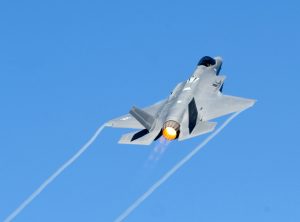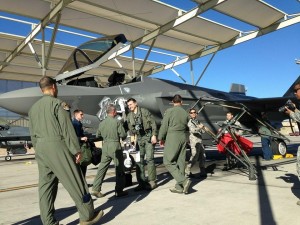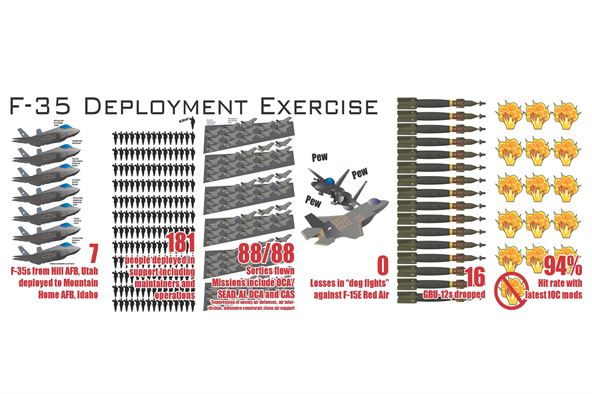2016-07-01 According to an interview with Col. David Chace, the F-35 systems management office chief and lead for F-35 operational requirements at Air Combat Command, the plane will be IOCd with the USAF later this year.
The interview is dated June 21, 2016.
JOINT BASE LANGLEY-EUSTIS, Va. –
The F-35A is on track to be declared initially operationally capable between August and December 2016.
IOC is the first step Air Combat Command will take in bringing the F-35 online as the latest fifth generation multirole fighter. In IOC configuration, the aircraft will be able to penetrate areas with developed air defenses, provide close air support to ground troops and be readily deployable to conflict theaters.
Col. David Chace is the F-35 systems management office chief and lead for F-35 operational requirements at Air Combat Command. He leads a multi-discipline team of maintenance professionals, program managers, operators and engineers not only with the responsibility for F-35 requirements, but also weapons systems fielding.
Below is a recent Q&A with Chace that outlines where ACC is in the IOC process.
Q1: What is the process for becoming IOC?
A1: There are a number of criteria that must be met in terms of capabilities and performance to become IOC.
The requirements, established in 2013, include 12-24 aircraft with trained and equipped Airman for basic close air support, interdiction and limited SEAD/DEAD in a contested environment and operating from a deployed location.
To support those operations we need the proper logistics and operational elements in place, including having the proper personnel, equipment and appropriate technical manuals.

Q2: Do you think you will reach IOC with just 12 F-35 aircraft?
A2: The forecast is that we will have more than 12 aircraft. There are currently 12 aircraft available at Hill Air Force Base, Utah. Some of those are going through the last few modifications required to support IOC. We will have additional aircraft in the modification process beginning in August.
Depending on the actual IOC date, modifications may be complete on the additional F-35s.
Q3: Who decides when the F-35 is IOC?
A3: The commander of Air Combat Command will make the IOC decision in direct consultation with the Chief of Staff of the Air Force.
It is a capabilities-based decision, with input received from units assigned to operational testing and evaluation at Mountain Home Air Force Base, Idaho and Nellis Air Force Base, Nevada and Edwards Air Force Base, California.
Q4: Where is the F-35 in the IOC timeline?
A4: Since beginning this process over five years ago with the first F-35s on the ground, we are in the final stages of IOC. These steps focus on training and equipping our personnel. There are no known technical issues today that would prevent us from reaching IOC in our August-December timeframe.
The F-35 recently deployed from Hill to Mountain Home where crews, maintenance and support personnel conducted a number of missions. During that deployment, crews attained a 100 percent sortie generation rate with 88 of 88 planned sorties and a 94 percent hit rate with 15 of 16 bombs on target.
These numbers provide a positive indication of where we are when it comes to stability and component performance.

Feedback from the events at Mountain Home will feed into the overall evaluation of F-35 capabilities.
The second evaluation will take place in the operational test environment with F-35 mission sets the Air Force intends to execute after IOC. All reports will be delivered in July and feed into the overall F-35 capabilities report. The ultimate goal is to provide a needed capability to the warfighter to execute the mission. It is not calendar-based or event-based.
Q5: What has the feedback been from the field so far?
A5: The feedback from unit operators in place today has been very positive for the F-35, not just concerning performance but the ability the aircraft has with other platforms. In particular at Hill, integration with the F-15E has gone very well. We’ve also been demonstrating the ability to put bombs on target. All of that information will be provided to us in the formal IOC readiness assessments.
Q6: What are some of the key metrics you’re hoping to see out of the deployment to Mountain Home?
A6: We’re looking for the ability to deliver combat power and the instruments that go into supporting that, such as aircraft stability and the capability to generate sorties. We’re also looking for feedback on the functionality of ALIS to support that sortie generation.
Q7: What weapons capability will the F-35 have achieved at IOC?
Q7: The F-35, a 5th generation aircraft, is a survival platform that can detect, track and engage targets in a contested environment. At the time we declare IOC we will focus on three mission sets that will concentration on the number and type of weapons the aircraft can carry.
Those weapons include two GBU-31s and two GBU-12s, or two AMRAAMs.
Q8: Is this aircraft capable of deploying to Iraq or Syria to battle ISIS like the F-22 did?
A8: After IOC, it will be available to support the needs of the combatant commanders.
Q9: How soon the F-35 will be deployed to overseas locations?
A9: There are a number of events being considered for the F-35, to include training exercises and deployments. These events are being assessed and planned for through the needs of the combatant commanders.

Q10: After IOC is declared, what are the next steps for the F-35?
A10: It’s a constantly evolving responsibility working hand-in-hand with our sister services and partners in development. We are actively engaged in the other activities taking place to field the F-35, such as system upgrades, such as Block 3F for full warfighter capability and future basing locations.
Additional squadrons are planned for Hill as well as at Luke Air Force Base with seven of the partner nations, Eielson Air Force Base, Alaska and locations in Europe and the Pacific.
The entry of the F-35 into Air National Guard units will take place in Burlington, Vermont and the first F-35 weapons school class at Nellis Air Force Base is also being projected on the timeline.
We also continue to evaluate the future threat environment and how the F-35 must adapt to remain survivable against those threats. Right now we’re looking at delivering the first increment of modernization to the F-35 in late 2020 or early 2021.
The USAF has released a graphic which highlights that the F-35 Joint Strike Fighter scored an 8:0 kill ratio against the F-15E during mock air combat.
Using combat-coded F-35As from Hill Air Force Base, the simulations were part of the evaluation process to declare the jet to be initially operationally capable.
The seven fighters used also demonstrated their ability to carry out basic close air support and limited SEAD/DEAD missions with crews attaining a 100% sortie generation rate with 88 of 88 planned sorties and a 94% hit rate with 15 of 16 GBU-12 bombs on target.
This is in contrast to the hyperbole in some quarters about the F-35 as a “dog fighter.”
07/02/2016: The first F-35A trans-Atlantic aerial refuel on the way to the United Kingdom.
As Lt. Col. Raj Cheri commented in an interview which we did with him earlier this year at Edwards AFB:
Question: We discussed the so-called F-16 and F-35 dogfight with colleagues earlier today, what is your take on this amazingly blown out of context story?
Answer: My first week here that story came out. I found the whole thing amazing because it did not even involve a simulated combat sortie. We were going after some particular test points.
The F-16 was simply a test aid, not in a dogfight with the F-35.
The story was simply spun and used by those who like to spin stories.
Because this happened just after I got here, I reached back to the leadership to determine whether this would have a chilling effect on our pilot reporting and discussions and was given clear guidance that we were not testing in response to the press, we were testing to evolve the aircraft.
That was made very clear from the top down. We are looking for accurate test and evolution of the aircraft, not a managed press campaign. Somebody else’s distortions are not going to deter our discussions.
And really, discussing the F-16 with the F-35 would be like a horse cavalry officer discussing the tank during the First World War.
You know the tank can not jump across the trench like a horse does!
That is correct and absolutely irrelevant.
The USAF Chief of Staff has us focused on the target of dominance in 2035 and not just carrying the legacy approach and fleet forward. The F-35 is a big part of that forward thinking.

